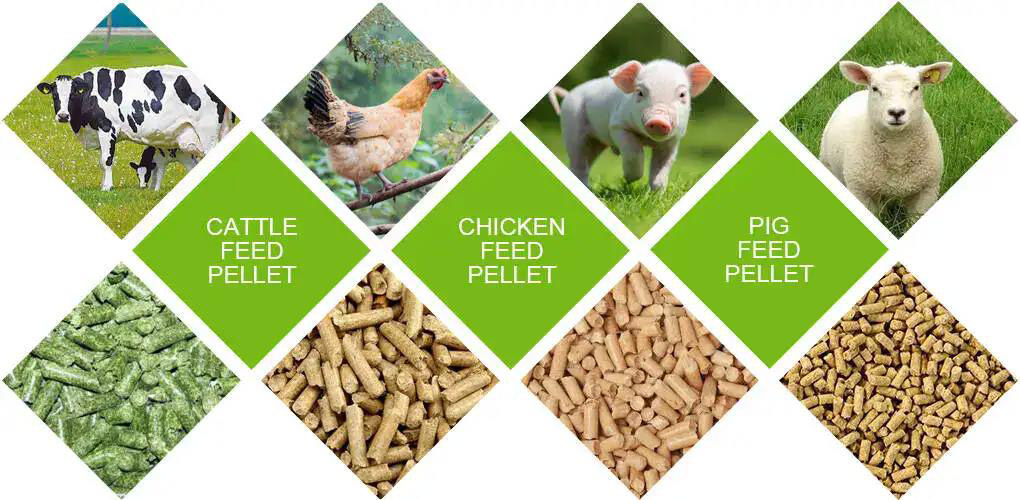Large Feed Pelletizer
A Large Feed Pelletizer is a piece of mechanical equipment designed for the production of animal feed pellets. It enhances the nutritional value, palatability, and storage efficiency of feed by compressing mixed feed ingredients into specific shapes and sizes of pellets.
Large Feed Pelletizer Introduction
A Large Feed Pelletizer is a piece of mechanical equipment designed for the production of animal feed pellets. It enhances the nutritional value, palatability, and storage efficiency of feed by compressing mixed feed ingredients into specific shapes and sizes of pellets. This machinery is widely used in large-scale farms, feed processing plants, and integrated agricultural enterprises.


Features of Large Feed Pelletizer
High Production Capacity
Capable of producing feed pellets on a large scale to meet the needs of large-scale breeding operations.
Diverse Raw Material Processing
Able to process a variety of different feed materials, including grains, grass powder, soybean meal, fish meal, etc.
Automated Operation
Typically equipped with automated control systems that reduce manual operation and increase production efficiency.
Adjustability
Allows for the adjustment of pellet size, shape, and density according to requirements.
Durability
Manufactured using high-quality materials to ensure the durability and long-term stable operation of the machine.
Ease of Maintenance
Designed with maintenance in mind for easy routine inspections and servicing.
Energy Efficiency
Utilizes energy efficiently to reduce production costs.
Adaptability
Suitable for producing feed for various animals, including poultry, livestock, and aquatic species.


The structure of Large Feed Pelletizer
Feeding System
The feeding system delivers raw materials into the pelletizer, typically including a hopper, conveyor belt, or screw feeder.
Conditioner
The conditioner adjusts the moisture and temperature of the raw materials by adding steam or water, ensuring optimal forming conditions.
Pelletizing Chamber
The pelletizing chamber is the core part of the pelletizer where the raw materials are compressed into pellets. It includes the die and rollers. The raw materials are forced through the holes of the die to form pellets.
Die and Rollers
The die determines the shape and size of the pellets, while the rollers press the raw materials through the die. Different combinations of dies and rollers can produce various specifications of feed pellets.
Cooling System
The cooling system cools the freshly formed feed pellets to prevent them from breaking or deforming at high temperatures. Air cooling or water cooling methods are commonly used.
Discharge System
The discharge system transports the cooled feed pellets to storage or packaging locations, commonly using conveyor belts or screw conveyors.
Control System
The control system regulates and monitors the operating parameters of the pelletizer, such as feeding speed, temperature, and pressure, ensuring a stable and efficient production process.


Advantages of Large Feed Pelletizer
High-Efficiency Production
A Large Feed Pelletizer can process a large amount of raw materials, suitable for the needs of large-scale farms and feed processing plants.
Improved Feed Utilization
By processing raw materials into pellets, it enhances animals’ digestion and absorption rates, reducing feed wastage.
Versatility
A Large Feed Pelletizer can handle various raw materials, such as corn, soybean meal, grass powder, and rice bran, producing feed pellets for different animals (e.g., pigs, chickens, cattle, fish).
Enhanced Feed Quality
Through the conditioning and pelletizing process, feed pellets have more uniform nutritional content, denser structure, and are easier to store and transport.
High Automation
Modern Large Feed Pelletizers typically come with automated control systems, allowing for automatic feeding, conditioning, pelletizing, cooling, and discharge, significantly improving production efficiency and operational convenience.
Energy Efficiency and Environmental Protection
The design of Large Feed Pelletizers usually considers energy efficiency, reducing energy consumption during the production process and minimizing environmental pollution.
Application of small feed pelletizer
Typically, the production of small feed pelletizer uses raw materials such as corn, soybeans, wheat, and other nutrients as the formula. Our small feed pelletizer are specially used to produce feed for poultry, livestock, pigs, horses, cattle, sheep, chickens, ducks, goose and other animals.For different animals, with different growth cycles, (chicks, suckling pigs, calves, etc.), the feed pellet size required is different, but our feed production line only needs to replace ring molds with different apertures or use a pellet crumbler to reach the required size.

Parameter of small feed pelletizer
| Model | Capacity | Main Motor Power | Feeder Motor Power | Conditioner Power | Dia. of Ring Die | Pellet Size |
| SZLH250 | 1-2T/H | 22KW | 0.75kw | 1.5kw | 250mm | 2-12mm |
| SZLH320 | 3-4T/H | 37KW | 1.5kw | 2.2kw | 320mm | 2-12mm |
| SZLH350 | 5-7T/H | 55KW | 1.5kw | 3kw | 350mm | 2-12mm |
| SZLH420 | 8-12T/H | 110KW | 1.5kw | 7.5kw | 420mm | 2-12mm |
| SZLH508 | 10-18T/H | 160KW | 2.2kw | 11kw | 508mm | 2-12mm |
| SZLH558 | 15-25T/H | 180KW | 2.2kw | 11kw | 558mm | 2-12mm |
| SZLH678 | 20-30T/H | 220KW | 2.2kw | 11kw | 678mm | 2-12mm |
| SZLH768 | 25-42T/H | 280KW | 2.2kw | 11kw | 768mm | 2-12mm |







